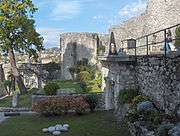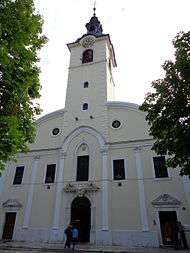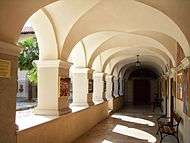Trsat


.jpg)
Trsat (Italian: Tersatto, Latin: Tarsatica) is part of the city of Rijeka, Croatia, with a historic castle or fortress in a strategic location and several historic churches, in one of which the Croatian noble Prince Vuk Krsto Frankopan is buried. Trsat is a steep hill, 138 m high, rising over the gorge of the Rječina river, about a kilometre away from the sea; strategically significant from the earliest times right up to the 17th century, it is today a major Christian pilgrimage centre and home to a statue of Pope John Paul II who came to Trsat as a Pilgrim in 2003.[1] Today, the Universtiy of Rijeka's newly constructed Campus lies in the western part of Trsat.
History
In the time before the Illyrians there was a fortified settlement and then the Illyrian (japodian) fortress Tarsatica. Following this there was a Roman looking point, and from the 13th century it was the property of the Counts of Krk. Later it belonged to the Frankopans. Together with Vinodol, the Croatian-Hungarian King Andrija II presented Trsat to Vid II of Krk. Towards the end of the 15th century the Habsburgs ruled Trsat and, even though it belonged to Croatia and the Frankopans, would not give it up because of its excellent position for the protection of Rijeka. The inhabitants of Trsat and Rijeka waged their fiercest battles with the Venetians in 1508, while in 1527 the Turks made inroads into the city for a short time.
In the 16th century, Trsat was more often in Habsburg than in Frankopan hands, and was mainly ruled by the Captains of Rijeka or Senj or leaseholds. After the execution of Fran Krsto Frankopan in 1671 following the Zrinski-Frankopan conspiracy proposed by Petar Zrinski, the Habsburgs took Trsat over completely. It was attached for a short time to the state of Severin, and in 1778 Maria Theresa placed it under the municipality of Bakar, where it remained, with a short break during the Napoleonic wars, until 1874 when the community of Trsat was founded.[2]
Trsat was an extremely patriotic Croatian town, and, together with Sušak, demonstrated its attachment to its mother country at every opportunity, and its independence from Rijeka, which was part of Hungary. The centre of political and cultural life in Trsat was the Croatian Reading Room, founded in 1877, with many cultural, educational and sports societies. Many memorial inscriptions and monuments bear witness to the resistance by the people of Trsat and Sušak to Italian and German occupation, a mortuary made according to plans by the architect Zdenko Sila and Zdenko Kolacio being outstanding.
Important sights
Trsat Castle

It stands on the site of an old Roman fortress and was built in the first half of the 13th century by the Frankopan Princes of Krk. From the beginning of the 15th century it had a succession of lords, but was most often owned by the Habsburgs. In 1528 the Senj Capitan Gašpar Raab bought the castle and adapted and greatly strengthened it. Once the danger from the Turks had passed at the end of the 17th century, and fire arms had come into use, Trsat fortress was less important and was left allowed to fall into ruins, a process which was completed by an earthquake in 1750. Count Laval Nugent, Marshal and military commander of the Austrian coastal area, bought the ruins off the city, for an annual payment of one florint and had it restored in a Romantic Classicist-Biedermeier-style.[3] He engaged the Venetian builder Paronuzzio and repaired the towers, decorated the interior and even built himself a mausoleum in the style of a Doric temple with four marble pillars supporting the facade. After his death his impoverished descendants deserted the castle and it once again fell into ruin until 1960. Since then it has been restored and enriched by the presence of art exhibitions, summer concerts and theatrical performances.
The Shrine of Our Lady of Trsat


The Shrine of Our Lady of Trsat (Croatian: Gospa Trsatska) is a church on the flat area at the top of Trsat hill and the subject of a legend dating from the 13th century. In May 1291 Mary's house in Nazareth is said to have appeared here, moved by angels from Nazareth, then mysteriously disappeared later, to be discovered in Italy, in Loreto, where it still stands today as a shrine.[4] According to one version the Holy House was brought from the Holy Land by the Crusaders. Prince Nikola Frankopan sent a delegation to Nazareth to measure the foundations as he had presumably only the stones in his possession and not the whole walls. He rebuilt the Holy House and the Frankopan Family then gave the Holy House to the Pope and, as the nearest Papal lands were near Ancona, the House was shipped there and placed in Loreto.[5] Tradition ascribes the building of the church to Prince Nikola I Frankopan (1307-1343) in 1291; it was extended and added to by his descendants. In 1453 Prince Martin Frankopan added on a nave to house a painting of Mary, believed to have been donated by Pope Urban V in 1367[3][6] and thought to have been painted by Luke,[7] and built a monastery alongside the church, occupied since 1468 by the Franciscans who are the guardians of the cult, which attracts many of the faithful. In 1644 a new nave was added to the church, which was extended and redone in Baroque style by the contributions of the members of congregation and Princes Frankopans. In 1691 the monastery was rebuilt after a fire and the complete reconstruction of the interior of the cathedral began, which was completed by the mid of the 18th century. In 1726 a new sanctuary above the crypt was built, giving the entire space luxury of ceiling decoration.[8]
A new artistic contribution to the church was made by Vladimir Kirin (1894-1963), with five pictures on the greenish marble slabs with which the shrine is lined, and another by Ivo Režek (1898-1979) who portrayed the 14 stations of the cross in fresco technique. One of the guardians of the Trsat monastery was the outstanding Glagolitic expert and writer of books in Croatian, Latin and Italian, Franjo Glavinič (1585-1652).
The Trsat Stairway
(To see the article Petar Kružić staircase).
It begins on the banks of the Rječina, beside a bank building, and leads up to the plateau at 138 m above sea level. There are 561 steps in all, and they were built for pilgrims on their way to the votive church. Work was started on them in 1531 by Petar Kružić, hero of battles against the Turks, who built the lower part of the stairway, later expanded to 538 steps.[7] The Baroque entrance hall in the form of a triumphal arch was built in the first half of the 18th century, and the votive chapels on the level ground near the church by the steps, between the 15th and the 18th centuries, one chapel each century.
Education
University Campus
In 2003, construction of the University of Rijeka's new Trsat Campus began on the site of a former army barracks on the western edge of the district, bordering the nearby district of Vežica, encompassing departments and faculties which were previously scattered around the city of Rijeka[9]. Opening in 2008, the campus now includes the Faculties of Applied Arts, Philosophy and Civil Engineering, along with the Departments of Informatics, Mathematics, Biotechnology and Physics.
Primary education
Trsat contains two primary schools (Osnovne škole): OŠ "Trsat", near to the Church of Our Lady of Trsat, and OŠ "Vladimir Gortan", near to the University Campus.
Gallery
 Old muzzle-loading gun at Trsat Castle
Old muzzle-loading gun at Trsat Castle Basilisk statue in courtyard
Basilisk statue in courtyard- Venetian lion near entrance
See also
References
- ↑ Novosti i Najave - Cardinal Bozanić unveiled a monument to John Paul II in Trsat. at Vlada.hr (in Croatian)
- ↑ Radovan Radovinovič, The Croatian Adriatic, pg. 78, Zagreb (1999), ISBN 953-178-097-8
- 1 2 Vesna Marić, Croatia: Dive into coral seas & a rich culture, pg. 122, Lonely Planet Publications, 5th ed. (2009), ISBN 1-74104-916-4
- ↑ Lovett Fielding Edwards, A Wayfarer in Yugoslavia, pg. 4, Publisher Unknown (2007), ISBN 1-4067-7535-5
- ↑ Paola Frankopan,Trsatska Sveta Kuča, Zagreb, 2003.
- ↑ William Garratt, https://books.google.com/books?id=Tr3Q8wlpHaEC&pg=PA103&dq=count+frangipani&hl=cs&ei=poaYTPyfGoaVswabmYWJDA&sa=X&oi=book_result&ct=result&resnum=2&ved=0CC8Q6AEwAQ#v=onepage&q=count%20frangipani&f=false Loreto the New Nazareth and Its Centenary Jubilee, pg. 33, Kessinger Publishing (2003), ISBN 0-7661-7861-7
- 1 2 Jeanne Oliver, Croatia, pg. 97-98, Lonely Planet Publications, 4th ed. (2007), ISBN 1-74104-475-8
- ↑ Radmila Matejčić, Kako citati grad: Rijeka jucer, danas, pg. 367, Izdavacki centar Rijeka (1988), ISBN 86-7071-056-0
- ↑ Ožanić, Nevenka; Hiro, Mirna (2010). "Sveučilišni kampus u Rijeci na Trsatu" (PDF). Građevinar. 62: 5.
External links
| Wikimedia Commons has media related to Trsat castle. |
| Wikimedia Commons has media related to Church of Our Lady of Trsat. |
- Kvarner Cultural History at Kvarner.hr
- Votive chapel of gifts at Mary's Trsat sanctuary near Rijeka at Croatia.org
- Rijeka, Trsat Webcam at Rijeka.hr, the official website of Rijeka
Coordinates: 45°20′N 14°28′E / 45.333°N 14.467°E